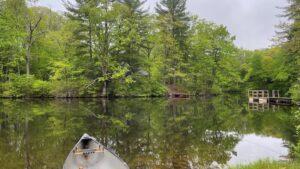Who is a member?
Our members are the local governments of Massachusetts and their elected and appointed leadership.

Worcester’s Cooks Pond received a rating of “Excellent” in the city’s recent State of the Lakes presentation. (Photo courtesy city of Worcester)
In Worcester, it takes a village on land to ensure that the city stays healthy in the water.
Worcester held its annual “State of the Lakes” presentation on March 14, serving as part report card, part review of the past year’s major developments involving the city’s 20-plus lakes and ponds. Overall, the city’s biggest and most prominent lakes fared well, said Katie Liming, coordinator of Worcester’s Lakes and Ponds Program, after the event. But the health of Worcester’s lakes and ponds also reflects the networks of individuals and institutions that care for the city’s much-appreciated blue spaces, she said.
“The main message was really just how fortunate we are in the city of Worcester to have so many different organizations and groups, all working toward the common goals of preserving the health of our waterways and improving recreation, and making everything better for everyone,” Liming said.
The March 14 event included remarks from Mayor Joseph Petty, a presentation from Liming, and findings from Laura Reynolds, an assistant professor at Worcester State University, on the effects of increasing urbanization on the Tatnuck Brook Watershed. Overall, the event focused on the program’s three-fold strategy of monitoring, management, and education and outreach.
Worcester started its Lakes and Ponds Program in 2016. Initially, the program existed in the city’s Public Works and Parks Department, but later it became part of a new Department of Sustainability and Resilience. The program connects to the goals of the Green Worcester Plan, and its work can be found on the city’s online Dashboard, which tracks progress on climate goals.
“Worcester’s lakes and ponds are valuable recreational, aesthetic and natural resources,” City Manager Eric Batista said in a statement about the program. “Worcester is lucky to have a program dedicated to proactively managing our waterways to preserve ecosystem services, in collaboration and coordination with many different partners throughout the community.”
The program monitors the city’s largest water bodies and includes water-quality reports on its website. To assess water quality, the city measures parameters including dissolved oxygen, temperature, pH levels, clarity, nutrients, fecal bacteria and cyanobacteria, Liming said. The city also tests every three years for industrial contaminants.
The monitoring helps inform Worcester’s approach to maintenance and management projects. The city uses the data to develop more targeted approaches to prevent and remove pollutants, discourage the growth of invasive aquatic plants, and reduce the threats that lead to larger environmental problems and beach closures.
“Our lakes are certainly very impacted, just by virtue of being urban natural resources,” Liming said. “We are so lucky, as a city, in Worcester to have these amazing recreational resources, but they are absolutely impacted by human development.”
One of the program’s newer projects involves the installation of an alum dosing station at Indian Lake to improve cyanobacteria management. The station, which went into operation last year, disperses polyaluminum chloride to reduce harmful algal blooms.
The two-employee program works closely with city departments, state agencies, the neighboring communities of Shrewsbury and Grafton through their work on the border-straddling Lake Quinsigamond Commission, local watershed associations, and area colleges and universities. Since 2017, the Worcester Cyanobacteria Monitoring Collaborative has trained more than 50 volunteers in collecting water samples to track cyanobacteria activity.
In addition to hosting the annual presentation, Worcester posts videos on its website, publishes a newsletter, and offers a text alert system to notify the public about beach closures, Liming said. Going forward, the program plans to produce a series of short videos on the state of the lakes and release them closer to the start of the recreation season.